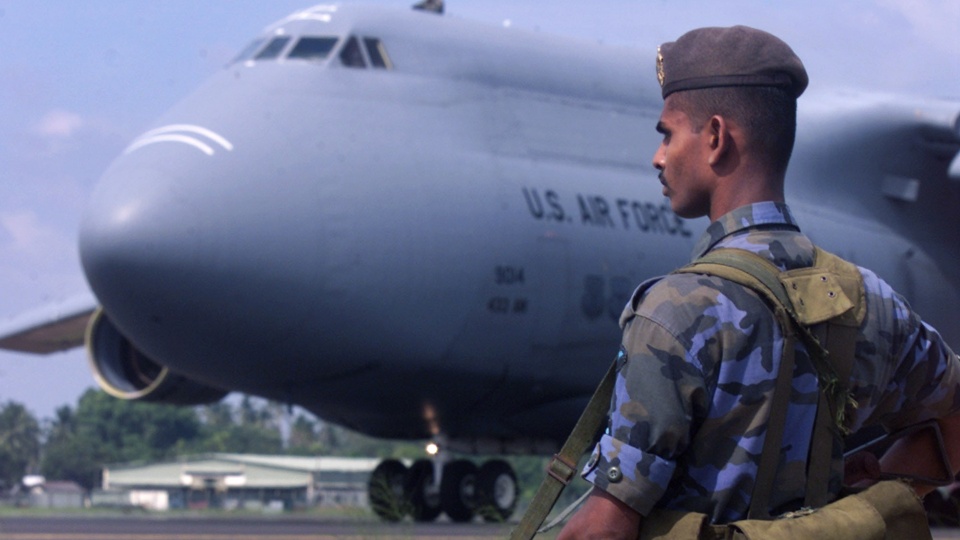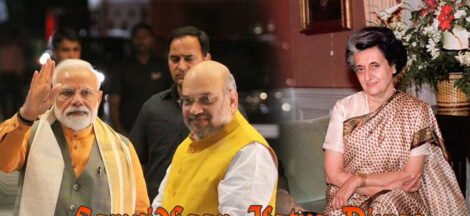By Shiran Illanperuma
NEW YORK: In 1964, during the second summit of the Non-Aligned Movement in Cairo, Prime Minister of Sri Lanka (then Ceylon) Sirimavo Bandaranaike proposed that the Indian Ocean be turned into a “zone of peace” that was free of military bases and nuclear weapons. In the context of heightened militarization during the Cold War, this proposal was supported by Indian Prime Minister Jawaharlal Nehru.
Sixty-one years later, the two countries have entered into a memorandum of understanding on defense cooperation. This is against the backdrop of a new wave of militarization in the Indian Ocean, including India’s own participation in the Quad (a group that also includes the U.S., Australia, and Japan), which is a component of the U.S.’ Indo-Pacific Strategy to contain China in a new Cold War.
On April 5, a defense MOU was exchanged between Sri Lankan Defense Secretary H.S. Sampath Thuyacontha and Indian Foreign Secretary Vikram Misri during an official visit by Indian Prime Minister Narendra Modi to Sri Lanka. Thuyacontha said that the agreement, which was not discussed in the Sri Lankan Parliament, will be valid for five years.
During a joint press statement with Sri Lankan President Anura Kumara Dissanayake, Modi said that he welcomed the “important agreements made in the area of defense cooperation,” without elaborating further on their contents. Meanwhile, Misri asserted that “the security interests of India and Sri Lanka are interlinked.”
News of the intent to sign a defense agreement first broke in Indian media on March 28, with the Press Trust of India framing it as “a move that comes amid China’s relentless attempts to increase its military influence over Colombo.” While official statements from both parties do not echo this anti-China framing, it nonetheless raises concerns over the prospect of the two nations being drawn further into a new Cold War.
India is a founding member of the Quad, a group first established in 2007, suspended in 2008 following the withdrawal of Australia, and re-established in 2017. The group exhibits strong security dimensions, as the member countries have engaged in joint military exercises, such as the Malabar Naval Exercise, which India hosted in 2024.
India is set to host the Quad summit this year, the first to be held since Donald Trump was elected president for a second term. In July 2024, Republican Senator Marco Rubio—currently Trump’s secretary of state—tabled a bill in Congress to grant India status on par with NATO members with regard to arms exports. While the bill has not made much headway in Congress, its basic agenda appears to be moving forward in other forms.
In February 2025, following a meeting between Modi and Trump in Washington, the two leaders announced an initiative called the “U.S.-India COMPACT (Catalyzing Opportunities for Military Partnership, Accelerated Commerce and Technology) for the 21st Century.” This includes a 10-year defense framework to facilitate the transfer of technology, expand the co-production of arms, strengthen military interoperability, and “support and sustain the overseas deployments of the U.S. and Indian militaries in the Indo-Pacific.”
India’s drift into the U.S. military-industrial complex and the new Cold War on China risks exacerbating tensions in Asia. However, India has at times also displayed what it terms “strategic autonomy” by taking an independent stance on issues such as the Russia-Ukraine conflict. In 2024, Indian External Affairs Minister S. Jaishankar also rejected calls by Japan for establishing an “Asian NATO,” arguing that India has “a different history and a different way of approaching” foreign affairs.
Since the end of its civil war in 2009, Sri Lanka has increasingly been drawn into the U.S. Indo-Pacific Strategy. According to the U.S. State Department’s 2022 Integrated Country Strategy for the country, the top mission objective is to “increase Sri Lanka’s interoperability with the United States and like-minded strategic partners.”
This has manifested in greater military cooperation between the two countries, as well as arms sales from the U.S. to Sri Lanka. According to data from Stockholm-based research institute SIPRI, some 36% of arms transfers to Sri Lanka between 2009 and 2024 were from the United States. These transfers included mainly helicopters and patrol ships.
In 2024, Sri Lanka played a role in the U.S.-led Operation Prosperity Vanguard against the Ansar Allah government in Yemen. The latter has been attacking Israeli-affiliated ships in the Red Sea in retaliation for the genocide in Gaza. The Sri Lankan navy ship SLNS Gajabahu, which was deployed for the operation, was originally a U.S. Coast Guard vessel commissioned in 1966 and donated to Sri Lanka in 2018.
More recently, a visit by U.S. Indo-Pacific Commander Admiral Samuel J. Paparo in March indicates the continued importance of Sri Lanka to the U.S. strategy in the region. During his visit to the country, Paparo met with President Dissanayake and Foreign Minister Vijitha Herath. In a speech delivered at the National Defense College in Colombo, Paparo said that “increased military cooperation among authoritarian nations” was creating challenges that necessitated “strengthening democratic partnerships.”
Less than 2,000 kilometres south of Sri Lanka, the U.S. has parked at least six B-2 stealth bombers at its base in Diego Garcia, in the occupied Chagos Islands. These bombers are used to attack targets in Yemen and also present an existential threat for Iran. For the U.S., control over the Indian Ocean is key for power projection onto both East and West Asia.
The Indian Ocean peace proposal was pushed onto the agenda of the 26th session of the U.N. General Assembly in 1971 by Sri Lanka, with the support of the United Republic of Tanzania (then led by Julius Nyerere). This led to the adoption of U.N. Resolution 2832—the “Declaration of the Indian Ocean as a Zone of Peace.”
The declaration sought to ensure: Warships and military aircraft would not use the Indian Ocean for any threat or use of force against any littoral or hinterland state. The right to free and unimpeded use of the zone by the vessels of all nations would be ensured. International agreement would be reached for the maintenance of the Indian Ocean as a zone of peace.
As the second Trump administration continues to intensify a new Cold War against China, peace in the Indian Ocean is once again at stake. India’s engagement with the Quad and Sri Lanka’s entrapment in the Indo-Pacific Strategy threaten to fan the flames of war in the region. However, history has shown that with social mobilization and principled leadership on either side, Sri Lanka and India could instead fight for peaceful development and cooperation in the Global South. (IPA Service)
Courtesy: People’s World




 Kerala To Blaze A New Trail With Heli-Tourism
Kerala To Blaze A New Trail With Heli-Tourism 